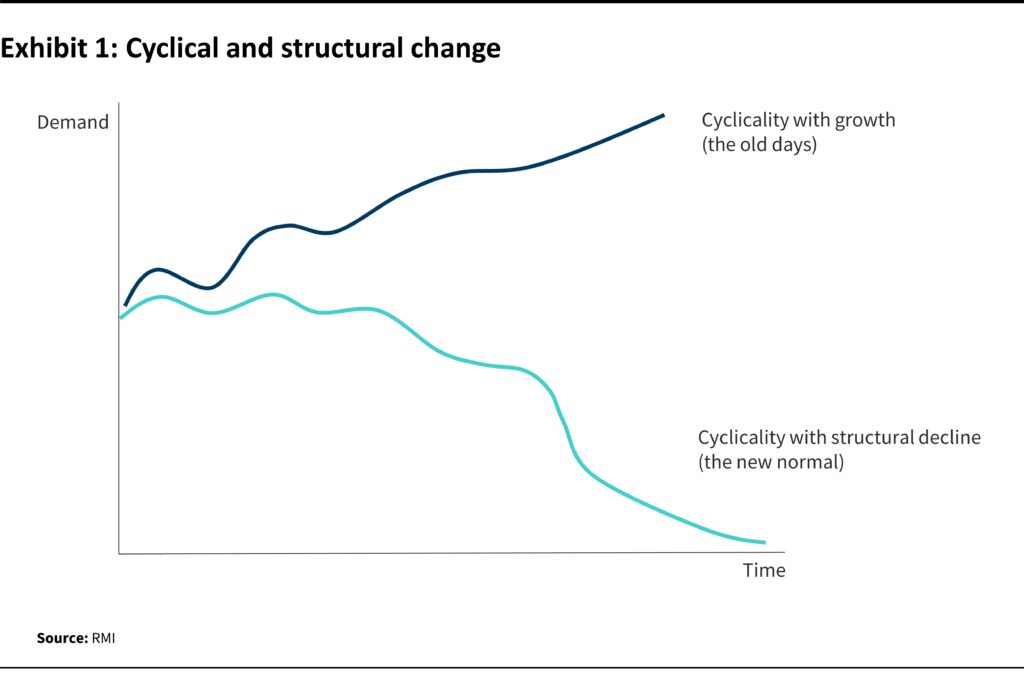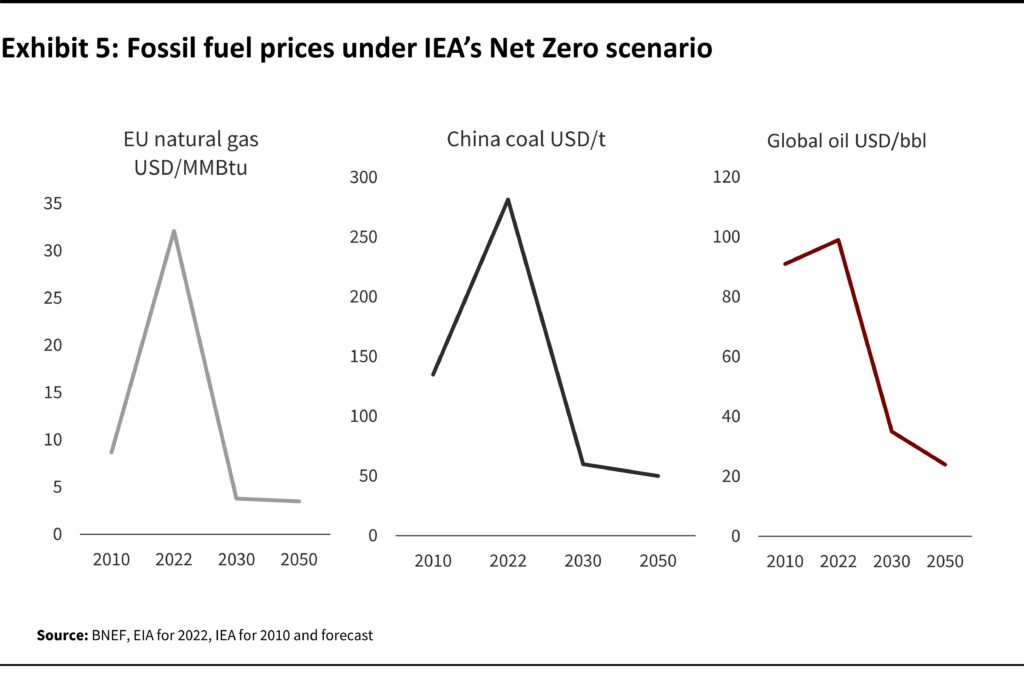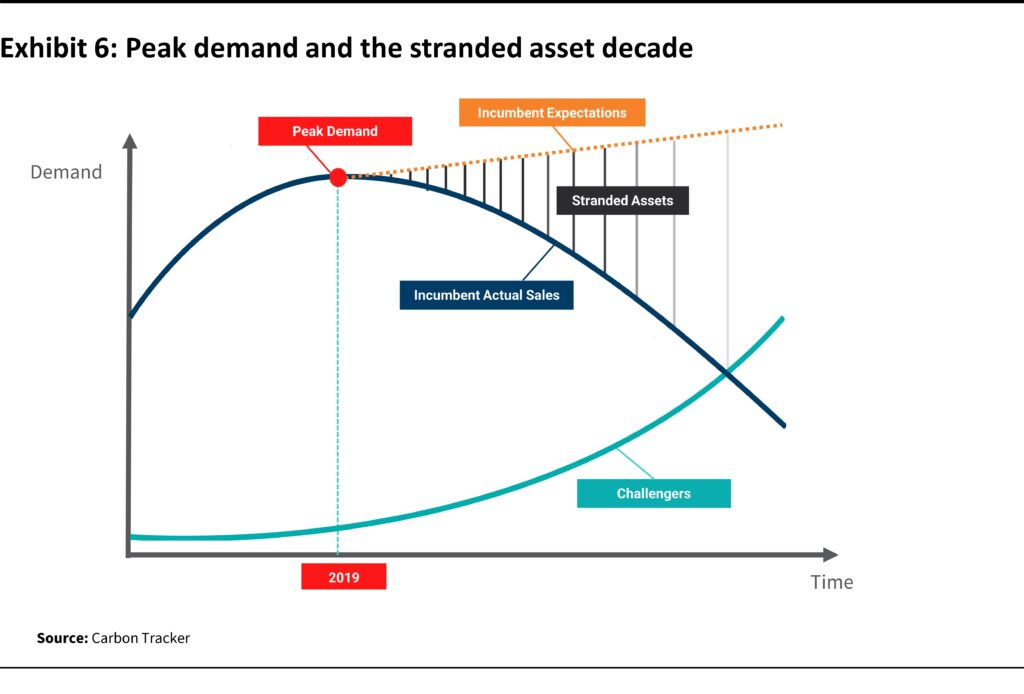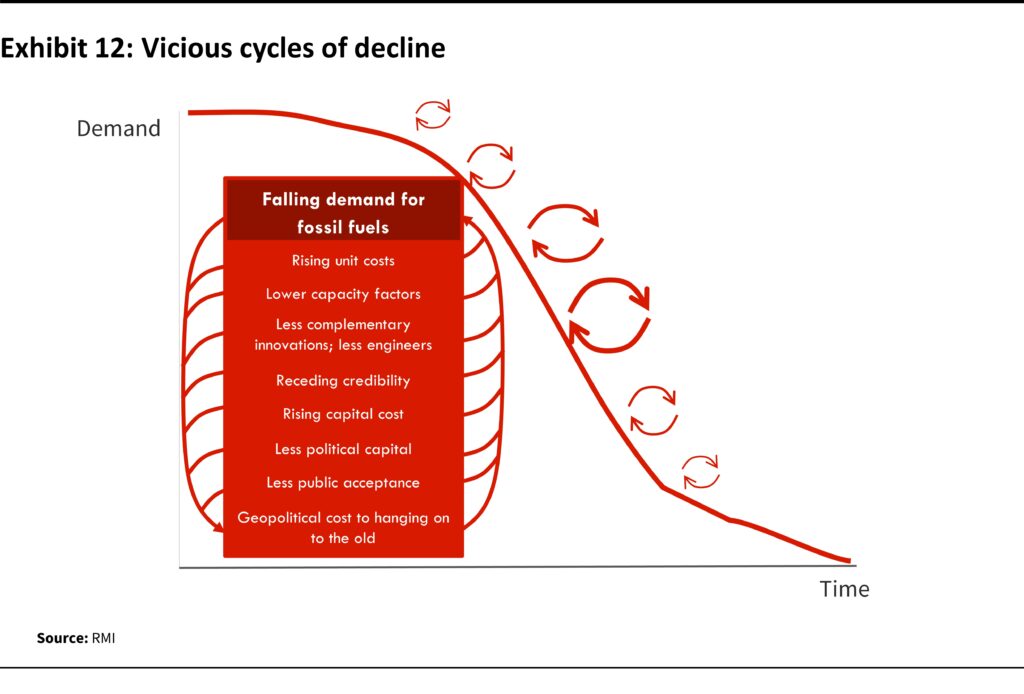
Sign-up to see new installments in our Climate Finance newsletter.
For more, see:
This is the third report in our series on peaking fossil fuel demand. It focuses on why peaks matter to financial markets.
1. Summary
Peaks matter because they separate the world of growth and opportunity from that of decline and risk. This is the reality that will face the fossil fuel industry in the aftermath of Putin’s War. Peaks mark the turning point.
- Volumes decline. After the peak, volumes decline. It may take time to become clear, and there will be cyclicality, but the long era of fossil fuel demand growth is over.
- Prices fall. As volumes decline in the face of a cheaper competitor, so prices will tend to fall. The current supply shock obscures this dynamic.
- Profits collapse. And as prices fall, profits of the low-margin, high-capital-intensity fossil fuel sector will fall more rapidly because of leverage.
- Assets get stranded. As volumes and prices fall, assets at the top end of the cost curve are rapidly stranded.
- Companies go bust. Companies that believe their own propaganda and fail to prepare for change will not be prepared for the new environment and will fail.
- Financial markets decline at peaks. For example, European fossil fuel electricity, US coal, or global oil services all saw a peak in their stock prices at the time of peak demand.
- Cost of capital rises. At the peak, the cost of capital rises, making it harder for incumbents to grow or even survive. Investors starve dying industries of capital.
Peaking thus kicks off a series of vicious cycles, from costs to technology and society to politics. The low-growth, low-margin, fossil fuel sector is highly vulnerable to peaks. And when the supply shock of Putin’s War fades away, the weaker parts of the fossil fuel system will be a soft target for hedge funds looking to short the losers of the transition.
2. The Turning Point
By definition, the peak is the point of no return. The top may be a bumpy plateau, but there is no return to the old growth. After the plateau, the future is simply one of decline.
We should distinguish between cyclicality, which is well known to the fossil fuel industry, and a structural shift, which is new. We have seen many cyclical shocks hit the fossil fuel system, but never before have we seen a structural shift.

The importance of turning points can be observed in many areas, from the personal to the geopolitical. Sports stars, ballet dancers, and gymnasts peak and then decline. They are still very good, but they no longer play for the first team or win Olympic medals. Cyclists struggle to the top of the mountain, but then speed down the other side. Empires spend centuries in expansion, only to collapse in a few years.
After the peak, demand inevitably falls. For example, supply of electricity from fossil fuels in Europe peaked in 2008 and has decreased by 30% since then (Exhibit 2).
3. Implications of the Turning Point
As demand begins to peak, the consequences are felt very early in the energy transition. This is important because much of the debate on the energy transition involves obscure and unwinnable arguments about events and technologies decades from now. The reality is that the process of change has already started and will be priced into financial markets during this decade.
It might seem odd to talk about the impact on the fossil fuel sector of peak demand at a moment when Putin’s War has created supply shocks across the energy system, when prices are high, and the industry is revelling in newfound profits. But supply shocks drive change, and when their effects fade, the industry will find itself all the more exposed. That was the story of the oil shocks in the 1970s, setting the scene for the collapse in fossil fuel prices in subsequent decades.
Our analysis looks forward to the point when the medium- and long-term effects of the peak have arrived. The shift is defined by the following cascade of effects.
Volumes Decline
Peak demand means a decline in the volume of sales. However, price declines linked to the volume decline do a lot more damage to incumbents than volume.
Prices Decline
There are two drivers of price declines: volume decline and the existence of cheaper alternatives at scale.
When demand starts falling, you soon get incumbent overcapacity, and that means price declines. A classic example is the US coal price in the period of overcapacity after 2008, when prices halved (Exhibit 3).
In the energy system, the risk is even greater because renewable technologies are cheaper and their costs fall on learning curves. So they get cheaper every year, while fossil fuels have a tendency to get more expensive as the cheapest resources are extracted first and the industry has to fight a battle of technology against extraction.
It is worth asking how fossil fuel prices can stay at such elevated levels in spite of the fall in renewable prices. And the answer is simply incumbency, size, and time. Incumbents are slow to change. Renewables take time to grow to be able to challenge fossil fuels at scale. So it takes time for the growth of renewables to affect fossil fuel prices. Nevertheless, the fossil fuel sector, like so many before it, faces enormous risk if its proponents believe that elevated prices can be maintained in the face of cheaper competition.
As a result of these factors, forecasters such as the IEA forecast lower fossil fuel prices in their net-zero scenario (Exhibit 5).

Profits Collapse
All businesses have a degree of leverage. So as prices decline, all else being equal, profits will fall faster.
For example, if the cost of extraction is $30 per barrel, and the selling price is $50, then an oil company will make a profit of $20. If, however, the price falls by only 20% ($10), then profits are halved. If it falls by $20, then profits are wiped out.
Although this is well understood, it appears to be a framing that is all too often lost on energy system modelers, who persist in assuming that the future will be the same as the past, and assume consistent margins. However, in the presence of cheaper superior competitors at scale, there is no reason why profits would remain elevated.
Assets Are Stranded
As soon as demand peaks and starts to decline, companies are left with stranded assets — assets that were built in the expectation of growth, but the growth did not happen. Assets at the top of the cost curve are immediately vulnerable, as Exhibit 6 illustrates.

Once there is overcapacity, companies have to close down redundant assets and write them off. The classic example of this happened in European electricity in the decade after 2008. Demand for fossil fuel electricity peaked, and all the supply growth came from renewables. At that point, recently built fossil fueled power plants had to be closed down, resulting in very considerable write downs as Exhibit 7 sets out.
Companies Go Bust
Not all companies are able to survive the brutal creative destruction associated with the end of growth. They build for growth and often get seduced by their own propaganda. Then when growth does not happen, they are saddled with debt and high-cost assets.
Classic examples of this are Peabody and GE, both confident that demand for fossil fuels would continue to rise, and both caught out by the speed of change. Peabody filed for bankruptcy protection in April 2016, and GE suffered a very significant derating after 2017. Meanwhile, in Europe, the electricity sector faced radical restructuring and the companies that survived had to reinvent themselves.
Markets React
Investors understand the risks of decline, so they tend to sell even before demand peaks. This gives rise to the well-known phenomenon of stock prices starting to fall even as sales volumes are still rising. We see this pattern time and again in financial markets.
For example, in 2007 the European electricity sector was still planning for demand growth, and still building new coal and gas generation stations. The sector derating started in June 2007 even before fossil fuel demand peaked at the end of that year (Exhibit 8).
Likewise, US coal demand peaked in 2007 shortly before the final spike in stock prices in June 2008. Within a decade many of the companies had gone bust (Exhibit 9).
Oil services capex peaked in 2014 and the index of global oil services stocks peaked in June 2014. By the end of 2020 the index was down by nearly 90%.
A gap often opens between the perception of financial markets and the perception of company management teams. Incumbent companies do not understand why their share prices are falling: demand is strong, size is huge, and they are rolling in cashflow. But that is how markets work — they price the future not the past. And the moment they see that decline is coming they will tend to sell.
Cost of Capital Rises
As investors exit the industry, the cost of capital for industry rises. The IEA compared the cost of equity capital in the oil and gas sector versus the renewable sector since 2006. The cost of capital for fossil fuels has been rising while for renewables it has been falling (Exhibit 11).
This then makes it harder for incumbents to raise money, which speeds up change in the process popularized by George Soros as reflexivity. This is another dynamic that is routinely missed by energy system modelers that assume the cost of capital is fixed through time.
Vicious Cycles of Decline Develop
Peaks also kick off a series of virtuous cycles for areas of growth, and vicious cycles for incumbents (Exhibit 12).

These cycles unfold across multiple fronts.
- Costs: As volume declines, costs are spread over lower volumes, so unit costs rise.
- Technology: As new technology platforms succeed, capital leaves the old ones. For example, most car companies have already abandoned new internal combustion engine platforms in order to focus on EVs.
- Expectations: As decline sets in, people anticipate more decline.
- Finance: Investors starve declining industries of capital and thus hasten change.
- Society: As people change, others follow. EVs are the classic example as people copy their neighbors in buying them.
- Politics: As politicians see the money and power shifting to the new, they stop protecting the old fossil fuel interests, especially in fossil fuel importers.
4. The Fossil Fuel Sector Is Highly Vulnerable to Peaks
Fossil fuels are extremely vulnerable to peaking demand. Specific reasons for their vulnerability include:
- Low growth: Demand growth is very low, averaging under 1% for fossil fuels over the past decade.
- Capital intensive: Fossil fuel systems are capital intensive. The capex to sales ratio is very high. That makes them vulnerable to lower selling prices or higher costs of capital.
- Commodity products: The clue is in the name — fossil fuels are commodities. As superior renewable alternatives are built, people will use them. As RMI co-founder Amory Lovins has famously noted: Consumers covet energy services, not energy; cold beers and warm showers, not barrels of oil and lumps of coal.
- Fragmented supply chain: OPEC has been able to build an oil cartel, but most parts of the fossil fuel system are highly fragmented; this discipline will certainly come under pressure as demand and price start to fall.
- Untaxed externalities: The fossil fuel system imposes upon society externality costs greater than the profits it generates. As alternatives get cheaper, governments in energy-importing countries will seek to make fossil fuel companies pay that externality cost.
- Low margin at the top end of the cost curve: Large parts of the fossil fuel system (e.g., refiners or high-cost oil producers) have very low margins. That makes them very vulnerable to a fall in price.
- Large rents at the bottom end of the cost curve attract competition: Rents are the gap between the extraction cost and the selling price. They tend to accrue to low-cost producers in systems with rising demand. The fossil fuel system makes $1 trillion to $2 trillion a year in rents, even more in 2022. This provides a huge incentive to other suppliers looking to substitute those fuels.
- No experience of systemic change: The industry has had no experience of systemic change. As its advocates like to point out, demand has always risen over time. That creates a growth mindset that is hard to dislodge and means that the industry is very complacent.
- Planning on expansion: As many people have pointed out, the fossil fuel industry continues to plan on expanding supply.
5. Conclusion
We stand at the cusp of major change as growth turns to decline across the entire fossil fuel system.
This dynamic has been obscured by the supply shock resulting from Putin’s War, but the reality will become much clearer once that shock fades away.
This report shows why investors should care about this moment of change. Investors in incumbent industries inevitably face major losses as growth turns to decline.